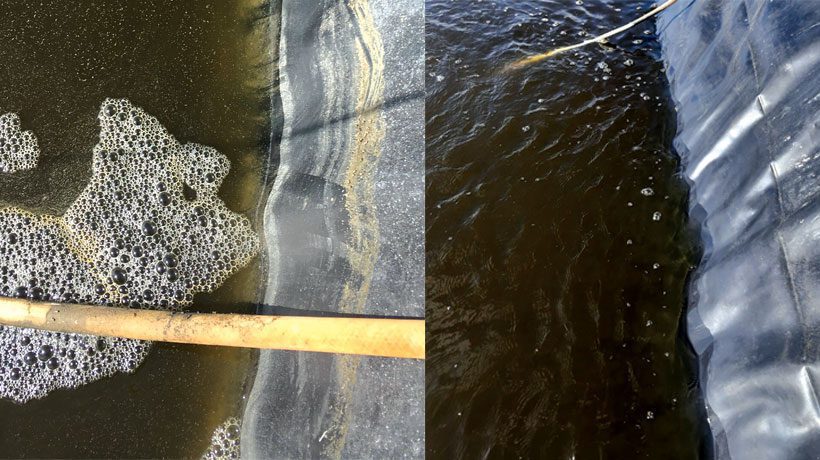TREATING VISCOUS TARPAULIN BY COMBINING ENZYME AND MICROBIAL
Shrimp farming in canvas ponds is a method chosen by many farmers. The tarpaulin cover when lining will prevent the penetration of organic pollution, alum, bacteria under the pond bottom mud, etc., thereby preventing the formation of tar and maintaining good water quality. The tarpaulin will help clean the pond bottom, and the excess food will not be mixed in the bottom mud layer, so it will increase the feed conversion rate, and increase the ability to eat at the bottom of the shrimp. However, the phenomenon of viscous tarpaulin often occurs, causing many farmers to have a hard time.
The causes of viscous tarpaulin
- Excess food and shrimp waste settle to the bottom, making the pond bottom more and more sludge.
- The water supply is contaminated with organic matter.
- The pond water is too clear, the light penetrates the bottom of the pond, causing algae and viscous algae to grow.
- Water is contaminated with alum, and heavy metals settle down, causing the appearance of a viscous bottom.
- Floc collapse (dead floc particles) combined with anaerobic bacteria will form viscous.
The harm of viscous tarpaulin in shrimp farming
When the phenomenon occurs, shrimp will be difficult to raise, increasing costs and reducing economic efficiency
- The bottom viscous is home to bacteria, fungi, and protozoa.
- It is a causative agent of intestinal and liver disease in farmed shrimp.
- Compete for nutrients and inhibit beneficial algae growth.
- Viscous seaweed after decomposition will be born when poisonous.
- Food mixed in viscous will reduce the ability of shrimp to catch prey.

Lubricants seriously affect the efficiency of the farming crop. Photo: Thai Nam Viet
Treatment
- Manual tarpaulin, using HCl helps to clean the canvas after harvesting, this method is very laborious and costly.
- Strictly manage the feeding, and reduce the amount of excess food that is a source of nutrients for the development of viscous algae.
- Maintain appropriate water level, cause watercolor, and create stable transparency 30-40cm to prevent light from reaching the bottom of the pond.
- Using probiotics :
- Enzyme preparations: Protease, Amylase, and Cellulase …, help decompose algae and residual organic matter.
- Microbial products: a strain of beneficial bacteria Bacillus capable of decomposing excess organic matter, secreting enzymes to cut algae.
Proposed solutions from Thai Nam Viet
Besides the usual measures, THAI NAM VIET COMPANY has researched and developed a method of combining Enzymes and microorganisms to treat lubricants, providing quick and safe results but with low cost and human resources. labor. Just beat 1-2 beats with the combination of “Enzyme-Micro-Enzyme” and it will clean the grease in 12-24 hours, reducing the effort and cost of scrubbing. In addition, the periodic use of “Enzyme-Micro-Enzyme” can limit viscosity, maintain good water quality, and help aquatic animals grow healthy.

PROCOZOLL
A synthetic form of 5 enzymes: Protease, Amylase, Cellulase, Lipase, and Urease, helping to control toxic algae and organic sludge
TNV CLARITY PLUS
Microbiological products specializing in the treatment of algae, excess organic matter in ponds, with bacterial species such as Bacillus subtilis, and Bacillus amyloliquefaciens …







